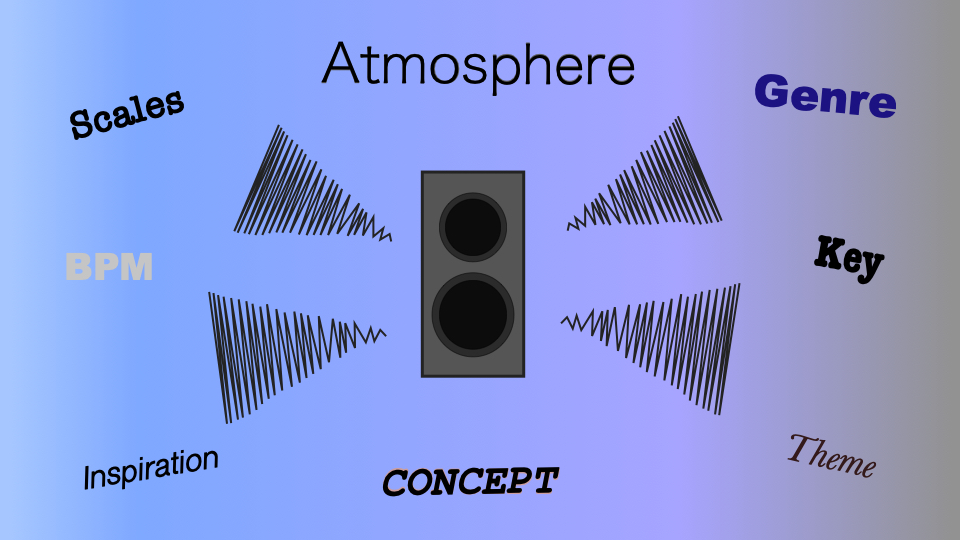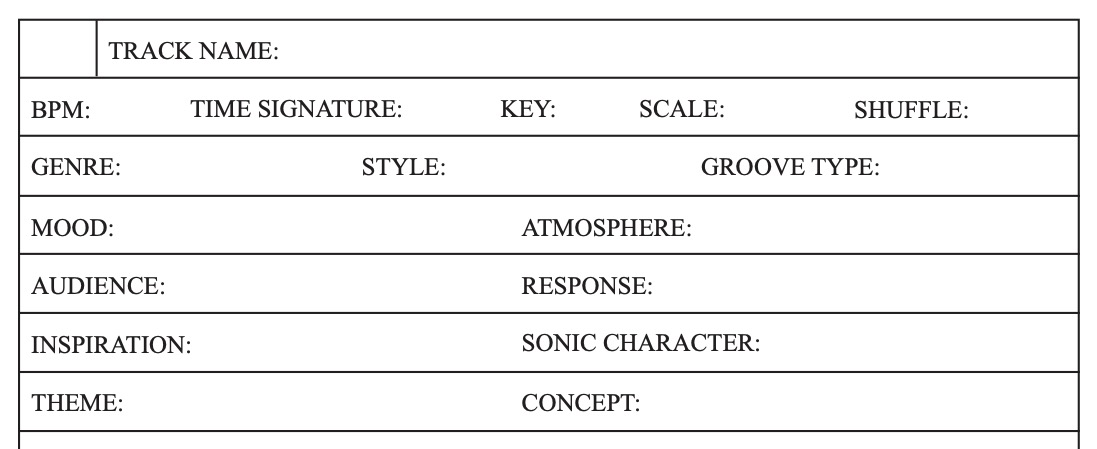A look at the Track Sheets part 1

Get familiar with the details
In our workbook ‘Finish 50 Tracks’, the details section is most important for making great music. This part of the ‘Track Sheets’ is made to get you out of the 16 bar loop or mind block you may be stuck in.
Or you can use it to create a template for a track you are yet to start.
How this section works, is by asking you to answer questions about your track; what you do know and what you may not yet have thought of. This task will force you to become more objective. This is useful because we can become emotionally involved, which is great for initial creativity but can become stressful if we hit the proverbial brick wall.
The main thing to remember is to not get stressed over answering the questions on the sheet. The answers may not come to you initially so don’t worry, let them come to you as you continue to work through the sheet, or later on when your doing something else, as is quite often the case with me.
For Example the first detail to fill out is Name. You may not have decided this so don’t force it. The best thing to put here, if you don’t already have one, is whatever you have named the project on the device you are working in. This makes logical sense in terms of time and coming back to it at a later date. The right name sometimes evolves out of the music as you go along.
Other more obvious details are BPM and Groove settings. Now is the time to consider if you are happy with the current pace of the music. Sometimes we start a track without changing the default settings and then we are at risk of being stuck with them.
The more thought provoking details are GENRE, STYLE, MOOD, ATMOSPHERE, AUDIENCE, RESPONSE, INSPIRATION, SONIC CHARACTER, THEME, and CONCEPT.
So let’s look at them two at a time…
GENRE and STYLE
Again these seem pretty obvious but have you considered both? Have you considered either at all? I used to think, “I just do my own thing and don’t conform” but it is helpful to have a few pointers from a genre. It helps narrow down choices if nothing else; from drum patterns to the type of sounds you use.
It’s great to break laws and tradition but you must first be familiar with what they are. If you really don’t think there is a style out there to encompass your unique blend, invent one. As long as your music has a target you will find it easier to move forward with fresh ideas and this is the real point of this exercise: To create a target and some boundaries in order to have something to aim for and less options to choose from. It is much easier to be creative with less as you don’t get overwhelmed by what some call ‘choice paralysis’.
MOOD and ATMOSPHERE
There are many ways to create mood and atmosphere. Different scales and chord progressions can influence mood a great deal and atmosphere can be created with reverbs, environment sounds, samples and voices. The question is, where do you want to take the listener? When you know this it’s just a matter of finding a way to conjure it up.
AUDIENCE and RESPONSE
Again a simple thing to consider but have you? It’s not just asking who your audience is but where are they likely to be? With this vision in mind you can think about how the music is going to go. Do you want lots of tension followed by big drops? Bumping music to keep the party grooving? Or just a happy song to sing in the car and help people escape from their worries on the way to work?
INSPIRATION and SONIC CHARACTER
Inspiration can come from anywhere. It could be another song or artist. Something you heard someone say or a quote from a film or an event in your own life. It could be a dream or an ideal or it could be a story from your religion.
Sonic character is the type of sound you are aiming for e.g. Dark and Bassy or Bright, Colourful and Polished or Punchy and LOFI. Having a few reference tracks can really help here as you can listen in and try to work out what they have done to get a particular sound. Yours will never be the same but it will be original so don’t be too hard on yourself.
THEME and CONCEPT
These two are usually associated with storytelling but it can be useful to consider them whether or not you are writing lyrics. So what are they?
Well, love is very popular so let’s start there…
A theme is what the story is about, so rather than being a love story, it can be a story of lost love and the battle to cope thereafter. This could take you down many avenues of what the protagonist goes through in order to cope. And it would all depend on how the person lost their love. Let’s say the person lost their love partner to an old friend. It could start as self destruction but turn into them becoming strong.
So the Concept could be the story told from the transformed persons point of view, of how they were prepared to get revenge and the dark thoughts that went through their head during the worst days, but are now liberated by seeing how the old friend is being suckered in by all the same things they were.
So theme = lost love
Concept = from a perspective of a new found freedom
But how would this work for a Techno record?
How about?…
Theme: The constant grind of industry coming to a sudden halt.
Concept: Dreams of a better future growing out of the void.
Maybe try writing a little story to go with it…
The industrial sound plays as distant memories clanging in the back of the mind. The city lights buzzing, new electric things, bright new colours amid the looming present darkness. All we can do is point forward and hope technology will get us to the new destination but all the while we are pulled into a distant past. Hypnotic drums put us in a trance and we dance and float through the mists of time. Visions of strange mythical creatures arrive in our heads. The clouds, the clouds are falling. There's no sky and the floor now feels so soft. Where are we? Is this a field? Then everyone begins to appear again. The floor firms up. It's a building, yes we're in a building. A massive abandoned factory. Shrieks of "Woo! Yes! Come on!". The beat comes back and smacks us in the chest. Then I open my eyes. I'm lying on my bed looking up at the ceiling.
Music really can take you places. Describe some of them in a note pad. Just writing out stuff like this can really get the mind going. It can be really useful when building your template without any music as it can give your song a motive and direction. Plus it can inspire lyrics. Just let go.
Conclusion
When you are stuck, filling out the details section can give you a break and allow you to get to know the music you are making. The trick is, to try and describe the feeling the music gives you and imagine where it may take you, or try picturing a scene in a movie or being at an event. All this can get you closer to what the music might be about. If you think your music is a bit predictable use ideas from your inspirations to change it up a little. It doesn’t have to be anything obvious like a sample, you could just use the same arrangement or similar fills they use. Your music is your’s and no one will be any the wiser as to where it all came from.
“Sometimes we find ourselves aimlessly trying stuff out, hoping for something good but that rarely happens.”
The clearer you can be on what your music is and what it needs to be, the easier it is to aim for something. Sometimes we find ourselves aimlessly trying stuff out, hoping for something good but that rarely happens. Most professional artists already know their story or motive for their music. They have experience in picking and making the right sounds and are very aware of their inspirations. So if the rest of us want to get anywhere close to their level we need to think out side the groovebox or DAW.
So try it today. Here is the top half of the 1st track sheet. Copy it into your notebook and give it a go.

Aside
We sell workbooks for music makers, you may already have one but if not here are some of the benefits.
- One place to keep your ideas instead of random scraps and post it notes everywhere.
- Organise your work and help keep your ideas fresh and easy to find.
- Different books for different tasks or preference.
- They look good ;)
Thank you so much for reading if you got this far, you are much appreciated.
Tags - Useful / Tips
01 Dec 2023 - WJC
